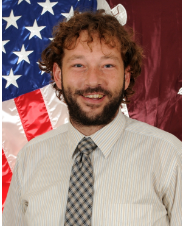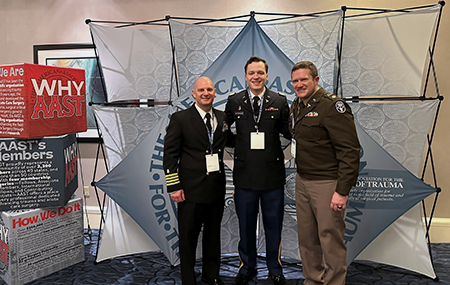Translational Physiology Lab – Dr. burmeister
ABOUT
Led by David Burmeister Ph.D., the research team is looking at the role of fluid resuscitation in organ (dys)function and inflammation, trauma intervention, burn wound healing and diagnosis, and the role of the microbiome on physiological homeostasis. The translational physiology program aims to extract basic science findings and expand them for advanced clinical relevance. Proof-of-concept studies in small animal models are followed by large animal models that have the advantage of incorporating clinically relevant tools and capabilities.
A fully functional two-bed Intensive Care Unit setup is housed at USU, which allows for the incorporation of catheters, monitoring systems, and other surgical tools that are used in human operating rooms.
news and updates
CPT Kyle Patterson, a General Surgery resident at Walter Reed National Military Medical Center, won the American College of Surgeons Committee on Trauma Army State Basic Science Presentation Competition at the 2025 AAST Fallen Surgeons Symposium and will next compete at the 2025 American College of Surgeons Excelsior Surgical Society meeting. The title of his presentation is "Functional and Physiologic Outcomes of Variable Limb Ischemia in a Porcine Model of Hemorrhagic Shock."
active grants
- RHE-24-01 ($858,564), Combat Casualty Care Research Program
“Microbiome Shifts Across Body Spaces after Countermeasures Targeting Intestinal Inflammasome Activation in a Swine Model of Combined Burns and Radiation”
- BA230106 ($647,576), Combat Casualty Care Research Program
“Pilot Multi-Center Observational Study of Resuscitation with Enteral Fluids”
- AFWERX-2024-0005A ($591,158), SBIR Subaward
“Advancing Military Healthcare: Novel Zwitterionic Hydrogels for Enhanced Wound Healing in Combat-Related Burn Injuries.”
- W81XWH-21-S-CRRP ($1,364,057), Combat Readiness Research Program
“Evaluation of a Novel Silicon-based Polymer- Universal Combat Matrix- in Large Animal Models of Wound Healing and Hemorrhage”
Publications
Patterson K, Dagher AM, Lackie M, Heyda LM, Baig Z, Mares J, Hutzler J, Green JT, Do W, Radowsky JS, Bradley M, Propper B, Burmeister DM, Walker P. User experience and hemostatic efficacy: Comparative analysis of commercial agents in junctional and hepatic hemorrhage models. PLoS One. 2025 Aug 29;20(8):e0330696.
Heyda LM, Dagher AM, Mares JA, Hutzler JD, Walker PF, Radowsky J, Bradley M, Burmeister DM. Novel silica-based polymer hemostatic matrix improves vessel patency rates in a coagulopathic porcine model with penetrating arterial injury. J Trauma Acute Care Surg. 2025 Aug 1;99(2):169-174.
Corrigan J, Mares J, Hutzler J, Nonneman D, Burmeister DM. The Incidence of Volatile Anesthesia Porcine Stress Syndrome in Pigs (Sus scrofa domesticus) Gives Implications for Physiology during Anesthesia. J Am Assoc Lab Anim Sci. 2025 Jan 1;64(1):179-188.
ArabiDarrehDor G, Kramer GC, Burmeister DM, Salinas J, Hahn JO. A mathematical model for simulation of cardiovascular, renal, and hormonal responses to burn injury and resuscitation. Front Physiol. 2024 Oct 3:15:1467351.
Tallowin S, Abel B, Mysore B, Mares J, Anderson JA, Propper BW, Stewart IJ, Burmeister DM. Canagliflozin Mitigates Acute Kidney Injury Secondary to Resuscitative Endovascular Balloon Occlusion of the Aorta in a Porcine Model of Hemorrhagic Shock. Ann Surg. 2024 Aug 23. doi: 10.1097/SLA.0000000000006501.

